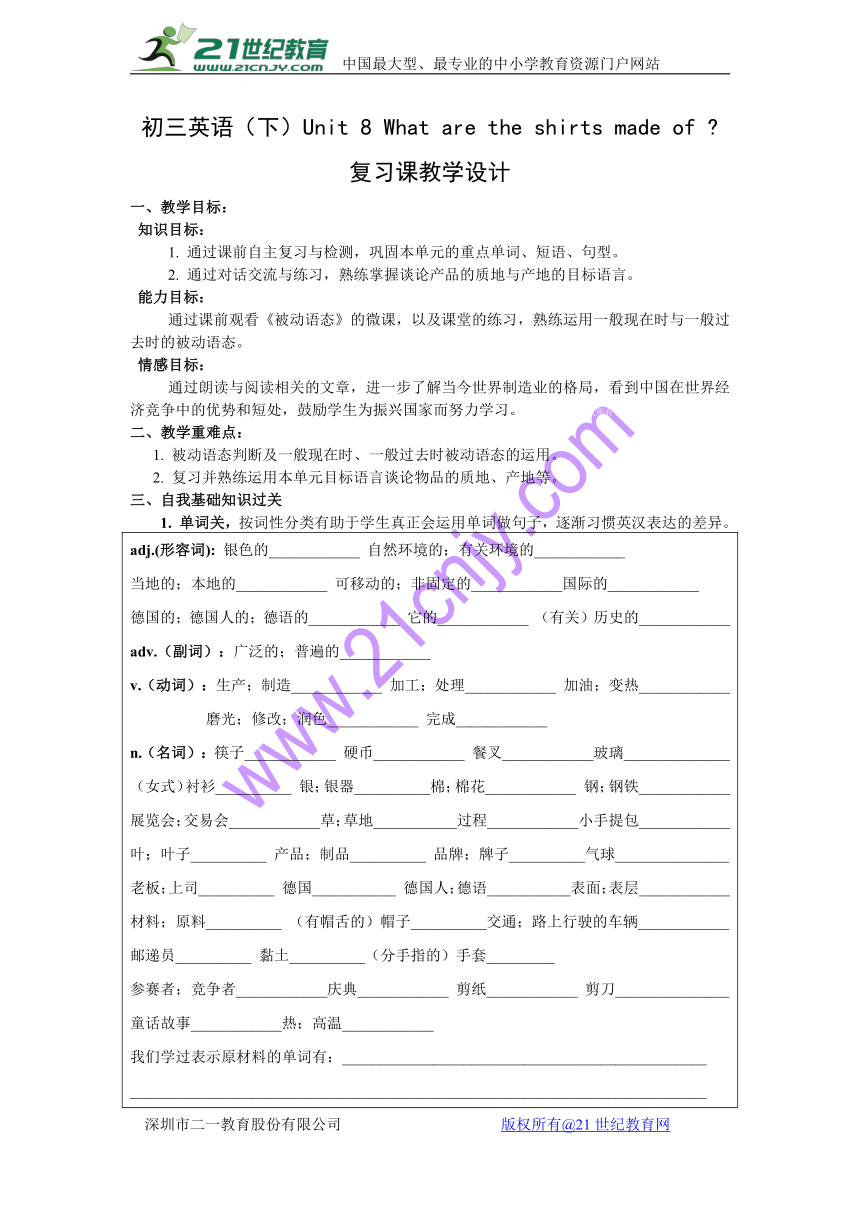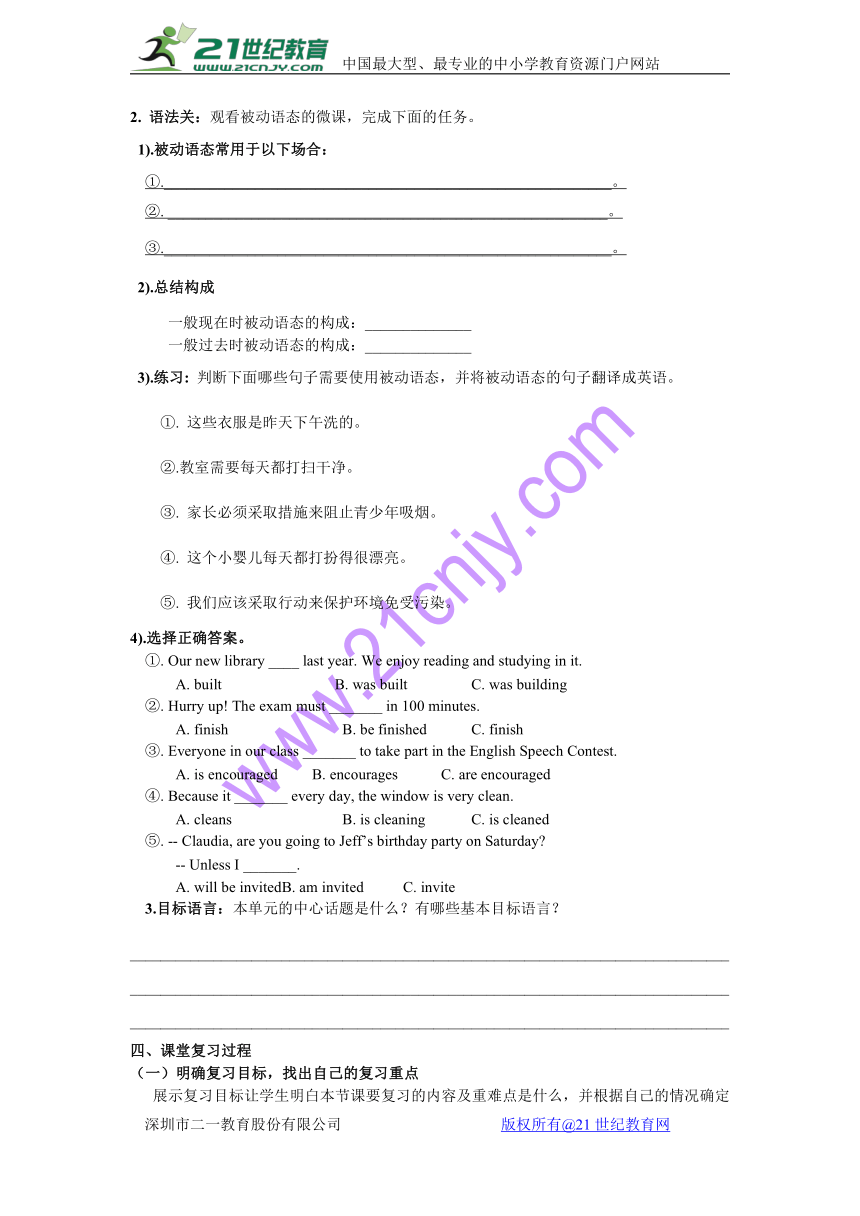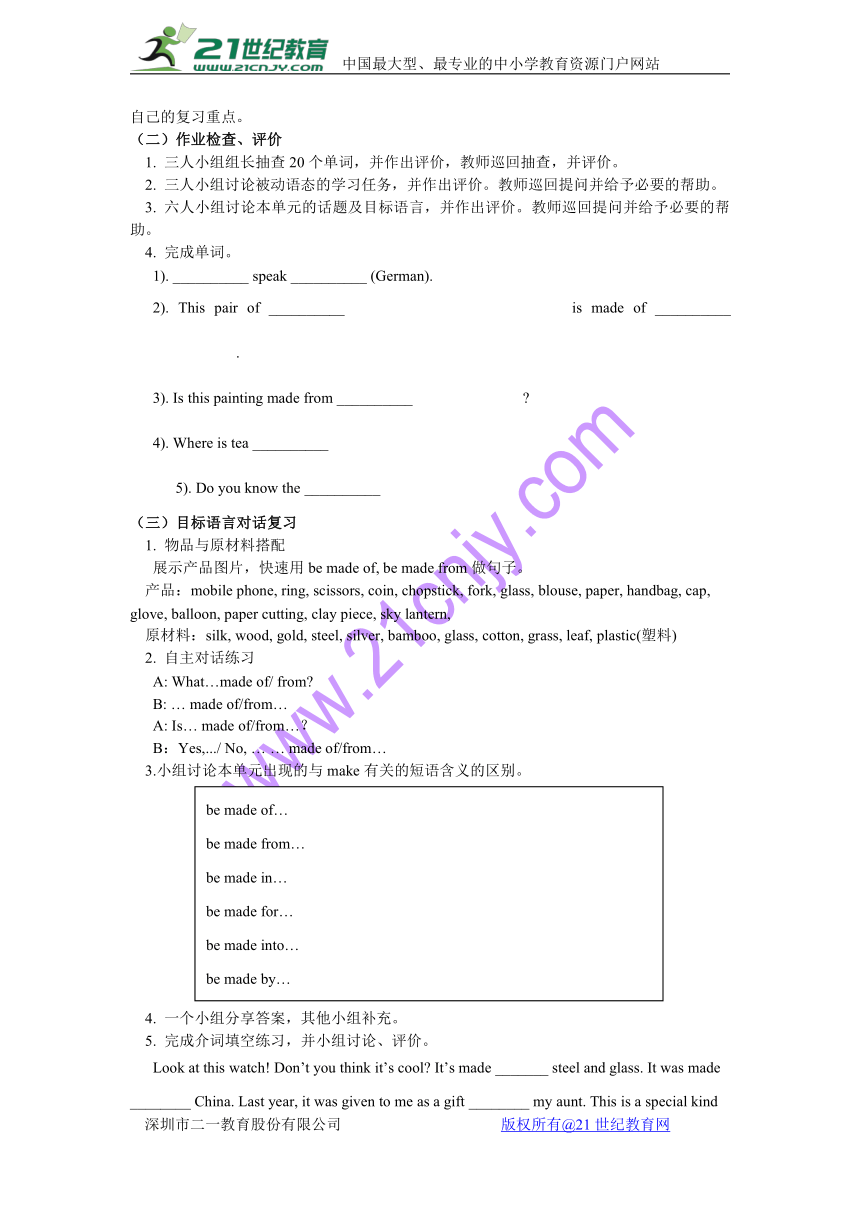Unit 8 What are the shirts made of? 复习课教学设计
文档属性
| 名称 | Unit 8 What are the shirts made of? 复习课教学设计 |

|
|
| 格式 | zip | ||
| 文件大小 | 76.0KB | ||
| 资源类型 | 教案 | ||
| 版本资源 | 鲁教版 | ||
| 科目 | 英语 | ||
| 更新时间 | 2017-12-25 08:03:53 | ||
图片预览



文档简介
初三英语(下)Unit 8 What are the shirts made of ?
复习课教学设计
一、教学目标:
知识目标:
1. 通过课前自主复习与检测,巩固本单元的重点单词、短语、句型。
2. 通过对话交流与练习,熟练掌握谈论产品的质地与产地的目标语言。
能力目标:
通过课前观看《被动语态》的微课,以及课堂的练习,熟练运用一般现在时与一般过去时的被动语态。
情感目标:
通过朗读与阅读相关的文章,进一步了解当今世界制造业的格局,看到中国在世界经济竞争中的优势和短处,鼓励学生为振兴国家而努力学习。21世纪教育网版权所有
二、教学重难点:
1. 被动语态判断及一般现在时、一般过去时被动语态的运用。
2. 复习并熟练运用本单元目标语言谈论物品的质地、产地等。
三、自我基础知识过关
1. 单词关,按词性分类有助于学生真正会运用单词做句子,逐渐习惯英汉表达的差异。
adj.(形容词): 银色的____________ 自然环境的;有关环境的____________
当地的;本地的____________ 可移动的;非固定的____________国际的____________
德国的;德国人的;德语的____________ 它的____________ (有关)历史的____________
adv.(副词):广泛的;普遍的____________
v.(动词):生产;制造____________ 加工;处理____________ 加油;变热____________
磨光;修改;润色____________ 完成____________
n.(名词):筷子____________ 硬币____________ 餐叉____________玻璃______________
(女式)衬衫__________ 银;银器__________棉;棉花____________ 钢;钢铁____________ 展览会;交易会____________草;草地___________过程____________小手提包____________
叶;叶子__________ 产品;制品__________ 品牌;牌子__________气球_______________
老板;上司__________ 德国___________ 德国人;德语___________表面;表层____________ 材料;原料__________ (有帽舌的)帽子__________交通;路上行驶的车辆____________
邮递员__________ 黏土__________(分手指的)手套_________
参赛者;竞争者____________庆典____________ 剪纸____________ 剪刀_______________
童话故事____________热;高温____________
我们学过表示原材料的单词有:________________________________________________
____________________________________________________________________________
2. 语法关:观看被动语态的微课,完成下面的任务。
1).被动语态常用于以下场合:
①.___________________________________________________________。
②. __________________________________________________________。
③.___________________________________________________________。
2).总结构成
一般现在时被动语态的构成:______________
一般过去时被动语态的构成:______________
3).练习: 判断下面哪些句子需要使用被动语态,并将被动语态的句子翻译成英语。
①. 这些衣服是昨天下午洗的。
②.教室需要每天都打扫干净。
③. 家长必须采取措施来阻止青少年吸烟。
④. 这个小婴儿每天都打扮得很漂亮。
⑤. 我们应该采取行动来保护环境免受污染。
4).选择正确答案。
①. Our new library ____ last year. We enjoy reading and studying in it.
A. built B. was built C. was building21教育网
②. Hurry up! The exam must _______ in 100 minutes.21cnjy.com
A. finish B. be finished C. finishwww.21-cn-jy.com
③. Everyone in our class _______ to take part in the English Speech Contest.
A. is encouraged B. encourages C. are encouraged【来源:21·世纪·教育·网】
④. Because it _______ every day, the window is very clean. 21·世纪*教育网
A. cleans B. is cleaning C. is cleaned
⑤. -- Claudia, are you going to Jeff’s birthday party on Saturday?www-2-1-cnjy-com
-- Unless I _______.
A. will be invited B. am invited C. invite
3.目标语言:本单元的中心话题是什么?有哪些基本目标语言?
_______________________________________________________________________________
_______________________________________________________________________________
_______________________________________________________________________________
四、课堂复习过程
(一)明确复习目标,找出自己的复习重点
展示复习目标让学生明白本节课要复习的内容及重难点是什么,并根据自己的情况确定自己的复习重点。
(二)作业检查、评价
1. 三人小组组长抽查20个单词,并作出评价,教师巡回抽查,并评价。
2. 三人小组讨论被动语态的学习任务,并作出评价。教师巡回提问并给予必要的帮助。
3. 六人小组讨论本单元的话题及目标语言,并作出评价。教师巡回提问并给予必要的帮助。
4. 完成单词。
1). __________ speak __________ (German).
2). This pair of __________???????????????is made of __________ ???????.2·1·c·n·j·y
3). Is this painting made from __________ ????????2-1-c-n-j-y
4). Where is tea __________ ??????????????
??5). Do you know the __________ ????????????????
(三)目标语言对话复习
1. 物品与原材料搭配
展示产品图片,快速用be made of, be made from做句子。
产品:mobile phone, ring, scissors, coin, chopstick, fork, glass, blouse, paper, handbag, cap, glove, balloon, paper cutting, clay piece, sky lantern, 21·cn·jy·com
原材料:silk, wood, gold, steel, silver, bamboo, glass, cotton, grass, leaf, plastic(塑料)
2. 自主对话练习
A: What…made of/ from?
B: … made of/from…
A: Is… made of/from…?
B:Yes,.../ No, … … made of/from…
3.小组讨论本单元出现的与make有关的短语含义的区别。
4. 一个小组分享答案,其他小组补充。
5. 完成介词填空练习,并小组讨论、评价。
Look at this watch! Don’t you think it’s cool? It’s made _______ steel and glass. It was made ________ China. Last year, it was given to me as a gift ________ my aunt. This is a special kind of watch made _________ teenagers. It’s made ________ hand. I like it very much. Do you know what other materials can be made ________ watches?21*cnjy*com
6. 全班交流、解决困难。
(四)教材对话复习
1. 大声朗读P58:2d对话,并且利用思维导图进行复述。问题如下:
Where is tea produced in China?
How is tea produced? (First…, When…, Then…, Finally…)
Why do people all over the world drink Chinese tea?
2. 三人小组交流复述内容。
3. 抽查,看哪个组复述的内容最全面。
(五)教材范文复习句法知识 1. 独立朗读、复习P59:3a, 找出下列句子中包括的从句。
1). No matter what you buy, you might think those products were made in those countries.
2). He found it interesting that so many products in the local shops were made in China.
3). He realized that Americans can hardly avoid buying products made in China.
4). Kang Jian thinks it’s great that China is so good at making these everyday things.
5). However, he wished that in the future China will also get better at making high-technology products that people can buy in all parts of the world.
2. 三人小组交流、评价。
3. 教师巡回检查、提问、评价。(2,3两句中划线部分所作句子成分相同吗?)
4. 全班交流。
5. 中国还擅长制造哪些日常生活用品?利用句子5进行情感教育:作为青少年应该为了振兴祖国而努力学习!国家兴亡,匹夫有责!
6. 重点知识点复习:
7. 翻译下面的句子
(1).?无论你喜欢那本书,我都会给你的。
(2). 无论Jim遇到什么样的麻烦,他都不会灰心。
(3). 长城全世界的人都知道。
(4). 乳山因为银滩而闻名于全国。
(六)听说训练
听录音,根据问题复述对话内容。
1). Where did Zheng Yun go on vacation?
2). Why did she go there? How was his holiday?
3). What do people from all over the world do at the festival?
4). Were the kites nice? What are they made of?
5). Are some kites painted with colorful drawings?
6). What did Laura say at last?
(七)教材范文语法知识综合复习
1. 三人小组朗读、复习P62页课文,注意语法知识点,重点复习使用被动语态的句子。
2. 完成短文填空
There are many different traditional art forms in China. They are known ____________ (for/to/as) to people all over the world. They ____________ (use) to show the things that are important in life, ____________, (for example/ such as) love, beauty and family.
According to Chinese history, Zhuge Kongming ____________ (use) sky lanterns first. Bamboo and paper are used to make ____________ (of/ from/into) sky lanterns. They ____________ (send) out to ask for help when in trouble in the past, but now they ____________ (use) at festivals and other celebrations.
It’s said that people ____________ (make) paper cutting for over 1,500 years so far. People usually use red paper. It need ____________ (fold) before it is cut ____________ (by/with) scissors. During the Spring Festival, they ____________ (put) on windows, doors and walls.
Both of them ____________ (see) as symbols of good wishes.
3. 三人小组交流、讨论答案。
4. 全班讨论难点。
(七)课堂检测:拓展阅读
1. 阅读下面的短文,回答问题。
An Accidental Invention
Did you know that tea, the most popular drink in the world (after water), was invented by accident? Many people believe that tea was first drunk about 5,000 years ago. It is said that a Chinese ruler called Shen Nong was the first to discover tea as a drink. One day Shen Nong was boiling drinking water over an open fire. Some leaves from a tea plant fell into the water and remained there for some time. It produced a nice smell so he tasted the brown water. It was quite delicious, and so, one of the world’s favorite drinks was invented.
A few thousand years later, Lu Yu, “the saint of tea”, mentioned Shen Nong in his book Cha Jing. The book describes how tea plants were grown and used to make tea. It also discusses where the finest tea leaves were produced and what kinds of water were used.
It is believed that tea was brought to Korea and Japan during the 6th and 7th centuries. In England, tea didn’t appear until around 1660, but in less than 100 years, it had become the national drink. The tea trade from China to Western countries took place in the 19th century. This helped to spread the popularity of tea and the tea plant to more places around the world. Even though many people now know about tea culture, the Chinese are without doubt(无疑的) the ones who best understand the nature of tea.
(1). Who was tea first drunk by? When was it first drunk?
(2). How was tea invented?
(3). What can we get in the book Cha Jing?
(4). What happened to tea during the 6th and 7th centuries?
(5). How long did it take to make tea the national drink in England?
(6). What does the world “this” in the last paragraph refer to?
(7). 将文章最后一句话翻译成汉语。
2. 三人小组交流答案。
3. 全班讨论难点。
(八)小结
中国擅长制造日常用品,但是在高科技产品方面还不够优秀。我们有责任将我们的日常用品发扬光大,更需要为提高中国制造高科技产品的能力而贡献自己的力量!
(九)作业
Group A:上网搜索瓷器、丝绸或者其它中国闻名于世界的产品,了解相关的信息,选择1-2重,仿照2a写一篇文章。
Group B: 复习学案上的内容,背诵。
复习课教学设计
一、教学目标:
知识目标:
1. 通过课前自主复习与检测,巩固本单元的重点单词、短语、句型。
2. 通过对话交流与练习,熟练掌握谈论产品的质地与产地的目标语言。
能力目标:
通过课前观看《被动语态》的微课,以及课堂的练习,熟练运用一般现在时与一般过去时的被动语态。
情感目标:
通过朗读与阅读相关的文章,进一步了解当今世界制造业的格局,看到中国在世界经济竞争中的优势和短处,鼓励学生为振兴国家而努力学习。21世纪教育网版权所有
二、教学重难点:
1. 被动语态判断及一般现在时、一般过去时被动语态的运用。
2. 复习并熟练运用本单元目标语言谈论物品的质地、产地等。
三、自我基础知识过关
1. 单词关,按词性分类有助于学生真正会运用单词做句子,逐渐习惯英汉表达的差异。
adj.(形容词): 银色的____________ 自然环境的;有关环境的____________
当地的;本地的____________ 可移动的;非固定的____________国际的____________
德国的;德国人的;德语的____________ 它的____________ (有关)历史的____________
adv.(副词):广泛的;普遍的____________
v.(动词):生产;制造____________ 加工;处理____________ 加油;变热____________
磨光;修改;润色____________ 完成____________
n.(名词):筷子____________ 硬币____________ 餐叉____________玻璃______________
(女式)衬衫__________ 银;银器__________棉;棉花____________ 钢;钢铁____________ 展览会;交易会____________草;草地___________过程____________小手提包____________
叶;叶子__________ 产品;制品__________ 品牌;牌子__________气球_______________
老板;上司__________ 德国___________ 德国人;德语___________表面;表层____________ 材料;原料__________ (有帽舌的)帽子__________交通;路上行驶的车辆____________
邮递员__________ 黏土__________(分手指的)手套_________
参赛者;竞争者____________庆典____________ 剪纸____________ 剪刀_______________
童话故事____________热;高温____________
我们学过表示原材料的单词有:________________________________________________
____________________________________________________________________________
2. 语法关:观看被动语态的微课,完成下面的任务。
1).被动语态常用于以下场合:
①.___________________________________________________________。
②. __________________________________________________________。
③.___________________________________________________________。
2).总结构成
一般现在时被动语态的构成:______________
一般过去时被动语态的构成:______________
3).练习: 判断下面哪些句子需要使用被动语态,并将被动语态的句子翻译成英语。
①. 这些衣服是昨天下午洗的。
②.教室需要每天都打扫干净。
③. 家长必须采取措施来阻止青少年吸烟。
④. 这个小婴儿每天都打扮得很漂亮。
⑤. 我们应该采取行动来保护环境免受污染。
4).选择正确答案。
①. Our new library ____ last year. We enjoy reading and studying in it.
A. built B. was built C. was building21教育网
②. Hurry up! The exam must _______ in 100 minutes.21cnjy.com
A. finish B. be finished C. finishwww.21-cn-jy.com
③. Everyone in our class _______ to take part in the English Speech Contest.
A. is encouraged B. encourages C. are encouraged【来源:21·世纪·教育·网】
④. Because it _______ every day, the window is very clean. 21·世纪*教育网
A. cleans B. is cleaning C. is cleaned
⑤. -- Claudia, are you going to Jeff’s birthday party on Saturday?www-2-1-cnjy-com
-- Unless I _______.
A. will be invited B. am invited C. invite
3.目标语言:本单元的中心话题是什么?有哪些基本目标语言?
_______________________________________________________________________________
_______________________________________________________________________________
_______________________________________________________________________________
四、课堂复习过程
(一)明确复习目标,找出自己的复习重点
展示复习目标让学生明白本节课要复习的内容及重难点是什么,并根据自己的情况确定自己的复习重点。
(二)作业检查、评价
1. 三人小组组长抽查20个单词,并作出评价,教师巡回抽查,并评价。
2. 三人小组讨论被动语态的学习任务,并作出评价。教师巡回提问并给予必要的帮助。
3. 六人小组讨论本单元的话题及目标语言,并作出评价。教师巡回提问并给予必要的帮助。
4. 完成单词。
1). __________ speak __________ (German).
2). This pair of __________???????????????is made of __________ ???????.2·1·c·n·j·y
3). Is this painting made from __________ ????????2-1-c-n-j-y
4). Where is tea __________ ??????????????
??5). Do you know the __________ ????????????????
(三)目标语言对话复习
1. 物品与原材料搭配
展示产品图片,快速用be made of, be made from做句子。
产品:mobile phone, ring, scissors, coin, chopstick, fork, glass, blouse, paper, handbag, cap, glove, balloon, paper cutting, clay piece, sky lantern, 21·cn·jy·com
原材料:silk, wood, gold, steel, silver, bamboo, glass, cotton, grass, leaf, plastic(塑料)
2. 自主对话练习
A: What…made of/ from?
B: … made of/from…
A: Is… made of/from…?
B:Yes,.../ No, … … made of/from…
3.小组讨论本单元出现的与make有关的短语含义的区别。
4. 一个小组分享答案,其他小组补充。
5. 完成介词填空练习,并小组讨论、评价。
Look at this watch! Don’t you think it’s cool? It’s made _______ steel and glass. It was made ________ China. Last year, it was given to me as a gift ________ my aunt. This is a special kind of watch made _________ teenagers. It’s made ________ hand. I like it very much. Do you know what other materials can be made ________ watches?21*cnjy*com
6. 全班交流、解决困难。
(四)教材对话复习
1. 大声朗读P58:2d对话,并且利用思维导图进行复述。问题如下:
Where is tea produced in China?
How is tea produced? (First…, When…, Then…, Finally…)
Why do people all over the world drink Chinese tea?
2. 三人小组交流复述内容。
3. 抽查,看哪个组复述的内容最全面。
(五)教材范文复习句法知识 1. 独立朗读、复习P59:3a, 找出下列句子中包括的从句。
1). No matter what you buy, you might think those products were made in those countries.
2). He found it interesting that so many products in the local shops were made in China.
3). He realized that Americans can hardly avoid buying products made in China.
4). Kang Jian thinks it’s great that China is so good at making these everyday things.
5). However, he wished that in the future China will also get better at making high-technology products that people can buy in all parts of the world.
2. 三人小组交流、评价。
3. 教师巡回检查、提问、评价。(2,3两句中划线部分所作句子成分相同吗?)
4. 全班交流。
5. 中国还擅长制造哪些日常生活用品?利用句子5进行情感教育:作为青少年应该为了振兴祖国而努力学习!国家兴亡,匹夫有责!
6. 重点知识点复习:
7. 翻译下面的句子
(1).?无论你喜欢那本书,我都会给你的。
(2). 无论Jim遇到什么样的麻烦,他都不会灰心。
(3). 长城全世界的人都知道。
(4). 乳山因为银滩而闻名于全国。
(六)听说训练
听录音,根据问题复述对话内容。
1). Where did Zheng Yun go on vacation?
2). Why did she go there? How was his holiday?
3). What do people from all over the world do at the festival?
4). Were the kites nice? What are they made of?
5). Are some kites painted with colorful drawings?
6). What did Laura say at last?
(七)教材范文语法知识综合复习
1. 三人小组朗读、复习P62页课文,注意语法知识点,重点复习使用被动语态的句子。
2. 完成短文填空
There are many different traditional art forms in China. They are known ____________ (for/to/as) to people all over the world. They ____________ (use) to show the things that are important in life, ____________, (for example/ such as) love, beauty and family.
According to Chinese history, Zhuge Kongming ____________ (use) sky lanterns first. Bamboo and paper are used to make ____________ (of/ from/into) sky lanterns. They ____________ (send) out to ask for help when in trouble in the past, but now they ____________ (use) at festivals and other celebrations.
It’s said that people ____________ (make) paper cutting for over 1,500 years so far. People usually use red paper. It need ____________ (fold) before it is cut ____________ (by/with) scissors. During the Spring Festival, they ____________ (put) on windows, doors and walls.
Both of them ____________ (see) as symbols of good wishes.
3. 三人小组交流、讨论答案。
4. 全班讨论难点。
(七)课堂检测:拓展阅读
1. 阅读下面的短文,回答问题。
An Accidental Invention
Did you know that tea, the most popular drink in the world (after water), was invented by accident? Many people believe that tea was first drunk about 5,000 years ago. It is said that a Chinese ruler called Shen Nong was the first to discover tea as a drink. One day Shen Nong was boiling drinking water over an open fire. Some leaves from a tea plant fell into the water and remained there for some time. It produced a nice smell so he tasted the brown water. It was quite delicious, and so, one of the world’s favorite drinks was invented.
A few thousand years later, Lu Yu, “the saint of tea”, mentioned Shen Nong in his book Cha Jing. The book describes how tea plants were grown and used to make tea. It also discusses where the finest tea leaves were produced and what kinds of water were used.
It is believed that tea was brought to Korea and Japan during the 6th and 7th centuries. In England, tea didn’t appear until around 1660, but in less than 100 years, it had become the national drink. The tea trade from China to Western countries took place in the 19th century. This helped to spread the popularity of tea and the tea plant to more places around the world. Even though many people now know about tea culture, the Chinese are without doubt(无疑的) the ones who best understand the nature of tea.
(1). Who was tea first drunk by? When was it first drunk?
(2). How was tea invented?
(3). What can we get in the book Cha Jing?
(4). What happened to tea during the 6th and 7th centuries?
(5). How long did it take to make tea the national drink in England?
(6). What does the world “this” in the last paragraph refer to?
(7). 将文章最后一句话翻译成汉语。
2. 三人小组交流答案。
3. 全班讨论难点。
(八)小结
中国擅长制造日常用品,但是在高科技产品方面还不够优秀。我们有责任将我们的日常用品发扬光大,更需要为提高中国制造高科技产品的能力而贡献自己的力量!
(九)作业
Group A:上网搜索瓷器、丝绸或者其它中国闻名于世界的产品,了解相关的信息,选择1-2重,仿照2a写一篇文章。
Group B: 复习学案上的内容,背诵。
同课章节目录
- Unit 1 When was heborn?
- Section A
- Section B
- Unit 2 It's a nice day, isn't it?
- Section A
- Section B
- Unit 3 Where would you like to visit?
- Section A
- Section B
- Unit 4 How can we become good learners?
- Section A
- Section B
- Unit 5 I think that mooncakes are delicious!
- Section A
- Section B
- Unit 6 Could you please tell me where the restroom
- Section A
- Section B
- Unit 7 I used to be afraid of the dark.
- Section A
- Section B
- Unit 8 What are the shirts made of?
- Section A
- Section B
